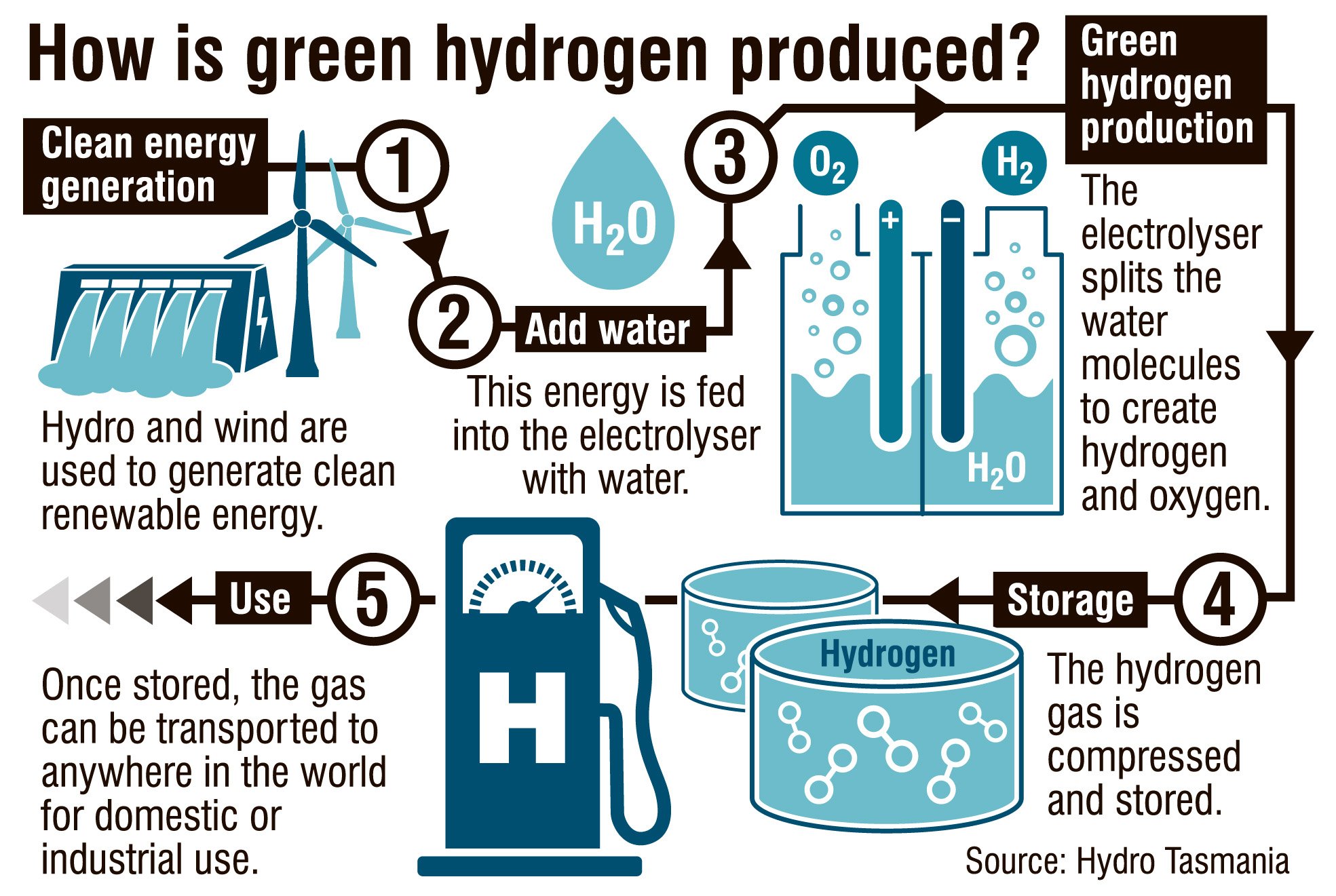The December 2024 end of the electricity sales agreement with New Zealand Aluminium Smelters, at Tiwai Point, prompted Contact Energy and Meridian Energy to announce a $2million feasibility study last year into a large-scale green hydrogen facility in the lower South Island.
The two power companies continued making the case for the project yesterday with a call for expressions of interest to develop a hydrogen production plant.

"We’ve got the opportunity to take the first step, the first step at scale."
Southland was well suited, due to available industrial sites and access to South Port’s deep port.
For Southlanders the project would mean many high-value jobs for the region, he said.
Contact chief executive Mike Fuge said the production facility would initially be aimed at global markets, but it could become hugely important domestically.
When hydro lakes were low, such as this year, operators could turn down the electricity provided to the green hydrogen facility, so it could be provided to the rest of the national grid, covering 40% of the dry year risk alone.
But the "mammoth" project would be intergenerational and have enormous capital requirements, he said.
"It needs a New Zealand Incorporated approach where private firms, iwi, government, all row together to get this project off the ground."
Market analysis by McKinsey & Co said the Tiwai Point smelter used about 12% of New Zealand’s largely renewable electricity.
About 99% of hydrogen now came from fossil fuels. Green hydrogen, from renewable energy, was an emerging field.
Global demand for hydrogen was estimated to grow by 7% a year from 2020, creating opportunities for exports to Asia, especially Japan and South Korea, before 2030.
Production costs were expected to decrease by more than 60% by 2030.
The benefits listed included:
- Hydrogen could reduce New Zealand’s gross long-lived greenhouse gas emissions by between 23% and 53%.
- The project could create a one-time benefit of an additional $1.6billion of gross domestic product.
- It could also generate up to $600million in ongoing GDP and up to 7000 ongoing jobs by 2030.
University of Otago chemistry professor Sally Brooker said many things were lining up for New Zealand to be a leader in green hydrogen.
Prof Brooker, who is also the Germany-New Zealand Green Hydrogen Alliance co-leader, said the market analysis rightly noted the high cost of producing green hydrogen now compared with fossil-fuelled hydrogen.However, the cost would drop over time as the scale of production rose, and the rising cost of carbon emissions would push the cost of dirty hydrogen higher.
A New Zealand Aluminium Smelters spokesman said the company’s contract with Meridian allowed it to continue operations until 2024, and it continued to work closely with the community and key partners, such as Ngai Tahu, to achieve the best outcomes beyond that date.
The BusinessNZ Energy Council welcomed the call for expressions of interest and said it would next week launch a briefing by the World Energy Council, titled "Innovation Insights Briefing: Hydrogen on the Horizon".
Benefits of hydrogen
- Today, about 99% of hydrogen comes from fossil fuels.
- Global demand estimated to grow 7% a year from 2020.
- Production costs expected to decrease by over 60% by 2030.
- Green hydrogen’s expected use includes chemical manufacturing, steel manufacturing, heavy transport, shipping, air travel, high-temperature industrial heat, and heat for buildings.
— Additional reporting Karen Pasco
Comments
Is it possible?
Yes.
Is it sustainable and does it make sense in terms of thermodynamic efficiency?
No.
Considering energy losses in all stages of hydrogen production and distribution:
The annual production of Manapouri Power Station 100% (4800 GWh)
The AC/DC conversion efficiency of approx. 95% (energy loss of 240 GWh)
The electrolysis process efficiency for a large plant is approx. 75% (further energy loss of 1140 GWh)
The efficiency of hydrogen compression is approx. 90% (further energy loss of 342 GWh)
The efficiency of transport/storage is approx. 80% (further energy loss of 616 GWh)
The efficiency of electricity production in a fuel cell is approx. 50% (further energy loss of 1231 GWh)
So, for an electrical energy input of 4800 GWh we have a final electrical energy output of 1231 GWh which is approx. 25% of the original value.
If liquefaction was to be used instead of compression the energy losses would be even greater
Energy requirements for desalination of sea water required for electrolysis have been ignored in the above calculations.
Unfortunately we can't yet change the laws of physics and The Hydrogen Dream is going to remain just a dream...
Why would Australia, Canada, China, France, Germany, Japan, Norway, South Korea, U.K., California, Chile, Saudi Arabia, and Portugal be making sizable investments in renewable hydrogen? "The EU plans to invest $430 billion in green hydrogen by 2030".
Are they all wrong?
"Passenger car diesel engines have energy efficiency of up to 41% but more typically 30%, and petrol engines of up to 37.3%, but more typically 20%."
That is at the time of combustion which compared to the fuel cell numbers you quoted, is poor.
There are considerable losses in processing and transporting diesel and petrol as well, not to mention finding the stuff.
Hydrogen can also be stored and transported as ammonia (NH3) in liquid form, then converted back before use.
Great for shipping, trains, tractors, trucks and possibly, long distance planes.
Hydrogen can also be used to manufacture steel and cement which currently contribute 9% and 5% respectively, globally, at current rates. Considering all the building that is going to be needed, that alone, would be a valuable contribution.
There is still so much to be sorted out with all the technologies but the biggest problem with wind and solar is storage and intermittency.
That's why I think 4Gen nuclear will be a major player on the global stage.
It's just a matter of costs for each sector.
It will happen, but by 2050 ?
The main thing is that it's done on a commercial footing, NOT a political one, like Think Big was.
"It needs a New Zealand Incorporated approach where private firms, iwi, government, all row together to get this project off the ground."
Why stop there?
Why not trade through a sovereign fund where profits are kept in foreign funds so the industry doesn’t swamp our currency, an effect known as Dutch disease.
This is what Norway did when it struck oil.
They learned from the Dutch industrial collapse resulting from their gas finds which inflated their currency to a point where few other industries remained internationally competitive.
Their sovereign wealth fund is now worth US$240,000 per person and their economy is strong.
Now is the time to get ahead of the game.
A much better use of our time and resources than the current moralising and petty below the belt punching of selected groups by those with a voice beyond their contribution to our country.
No mater what energy source we use, we will still be dumping heat into the atmosphere.
Hydrocarbon powered vehicles, Hydrogen powered vehicles, electric vehicles all require a cooling system to dump excess heat into the atmosphere.
Even "Green" hydro or Fusion power generation dump excess heat back in the environment.
Heat radiates back into space
Earth would be a snowball if it wasn't for greenhouse gasses
Once a snowball, it would stay that way unless a force was applied.
Water vapor is by far the greatest contributor at 95%, CO2 at 3.6% and the others at 1.4%.
Atmospheric pressure adds some heat when it is mobile
That is why an anticyclone (descending air) generally produces warmer temperatures and cyclones produce colder.
As it descends the air gets compressed against the earth, increasing its temperature at that level.
Although heat rises, it gets cooler at an average of 1.5C per 1000ft of altitude because of the decreasing air volume, hence pressure
Pre-industrial age CO2 was 0.028% of atmospheric gasses, it is now 0.043%
Every time you double the concentration of CO2 you get about 1.5C increase in its greenhouse effect
0.056% will give 1.5C, then it will require 0.112% to add another 1.5C but that does not account for the increase produced by more water vapor, other gasses or saturation level. It's complicated
Plants evolved at 2.4% and they can't survive with less than 0.015%
What is the best level for the earth, now we can geoengineer ???
We just don't know !!!
Well, yes, I guess no matter how we produce and run 'transport', there will always be heat emitted into the atmosphere. I think we could say the same thing with fire, steel smelting, jet engines, cooking, water heating, heat pumps etc, then all matter o natural heat sources.....volcano anyone. On the other side of it, would hydrogen used for transportation be better than fossil fuel for the planet? Everything we can currently advance as a viable alternative, will in some way, still damage the enviroment and potentially the atmosphere. So what do we do? We look at what we could develop NOW that has the least efect on the environment. Hydrogen? why not?
I like the idea of a sovereign wealth fund as described by Eyes Wide Open. It would give everyone the chance to take ownership of a new source of energy, instead of faceless international body corporates. Maybe New Zealand is in a postion to excersise a major turning point by converting the Tiwai plant into hydrogen production, and something we could all invest in. A community approach to lead the world? Better than mining rare metals for battery production? Potentially.......sign me up.....
Keep in mind the basic principle that energy cannot be derived from nothing. Where did the heat energy that is released from the combustion of hydrogen that was derived via electricity from hydro lakes come from? It would have to be from the sun causing moisture from the earth to gather in cloud, which then falls as rain etc to fill the lakes and push through the generators. The net energy gain/loss from this cycle is zero.












